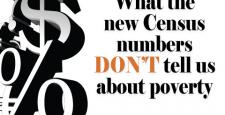Viewpoints: Poverty figures don’t reflect how programs have helped the needy
OpEd by Director Ann Huff Stevens and Data Librarian Jean Stratford on the recent Census report on poverty statistics
From the Sacramento Bee Opinion Pages, September 13, 2012:
The latest figures on poverty in the United States, released Wednesday by the Census Bureau, show that nearly 1 in 6 Americans live in poverty – little change in the rate over the past year. Experience suggests that this new data will be used to argue that spending on the poor doesn’t help and to buttress claims that the 50-year “war on poverty” is a failure. The problem with these arguments is that the official poverty statistics, by construction, obscure the effect of critical and growing parts of social program spending: non-cash assistance programs and tax credits directed to the working poor.
What do the official poverty statistics miss? Put simply, they miss most of the current social safety net for the non-elderly. Because official U.S. poverty statistics, including those released this week, focus exclusively on a family’s money income, any non-cash benefits (like food stamps or Medicaid) or after-tax resources (like the Earned Income Tax Credit, or EITC) are ignored in the official determination of who is in poverty.
The omission of such programs from official poverty statistics is more important than ever. In 2011, expenditures on traditional cash welfare totaled approximately $6.5 billion, while the Supplemental Nutritional Assistance Program (SNAP, formerly known as food stamps) provided $71 billion in food assistance to needy families; Medicaid provided nearly $200 billion for health care; and the EITC transferred nearly $60 billion to working poor families.
While debates over what might seem like narrow technical details in our official poverty measures take place largely outside the public eye, these measurement decisions are at the heart of the charged, emotional – and often inaccurate – public discourse on poverty and social policy.
For example, a report by the Cato Institute last year highlighted the billions of dollars spent on the poor, and then reached the shocking conclusion that, despite massive public spending, poverty has not declined. Of course, as even that report admits, that is largely because many of these benefits are excluded from the official calculation of who is poor.
Other, more meaningful, calculations and studies do show how public spending aids the poor. The Census Bureau’s own Supplemental Poverty Measure, for example, provides a gauge as to the value and impact of these non-cash and after-tax programs. These calculations show that counting the value of the EITC or food stamp benefits as income reduces the poverty rate in each case by approximately two percentage points.
Other evidence from peer-reviewed studies points to the true long-term benefits of many of these assistance programs. Nutrition assistance through food stamps and the Women, Infants and Children nutrition program improves birth weight, an important indicator of infant health and future life prospects. Increased Medicaid availability reduces infant and adult mortality and improves self-reported health and access to care. Transferring more income to poor families through the EITC improves the educational performance of children.
There can always be honest disagreements about the cost-effectiveness and affordability of particular programs, but these discussions have to include the true benefits of programs, not simply point to poverty rates that are, in a sense, rigged to be unresponsive.
To understand how social welfare spending affects poverty using simple comparisons between program spending and official poverty statistics, we would need an experiment in which a group of individuals was made categorically eligible for cash payments over a number of years. Fortunately, the history of the Social Security program provides us with just such an experiment.
The elderly are one group for which official poverty measures do capture the key source of broadly available government support; as a result, elderly poverty rates have fallen from 35 percent to 9 percent over the past 50 years. It would be misleading to extrapolate too much about programs for children and working-age adults from the experience of the elderly. Transfer programs can create perverse incentives for work and family formation that are less of an issue for the elderly. The fact remains, however, that the history of Social Security shows that income transfers can, and do, reduce poverty markedly when those transfers are broadly available and included in poverty measures.
In the midst of this election cycle, this week’s updated poverty figures provide more evidence that we continue to live in challenging economic times. We should not, however, let anyone use these new figures to argue that anti-poverty programs do not help the poor. Much relevant evidence suggests that they do help, but we have to look beyond the official poverty statistics to see it.









